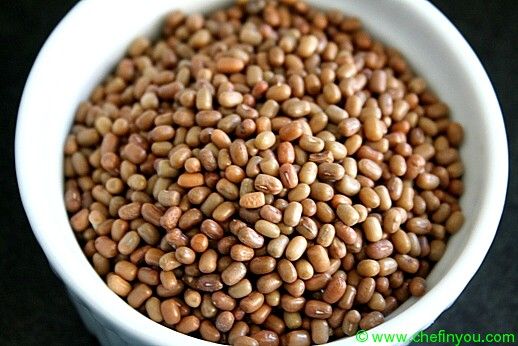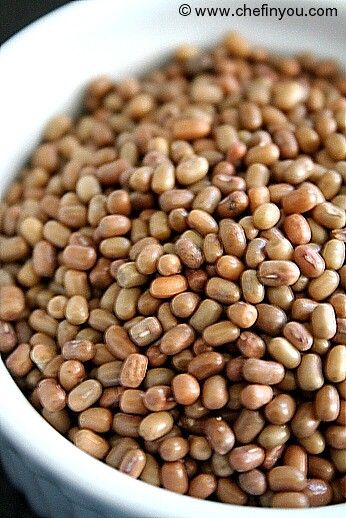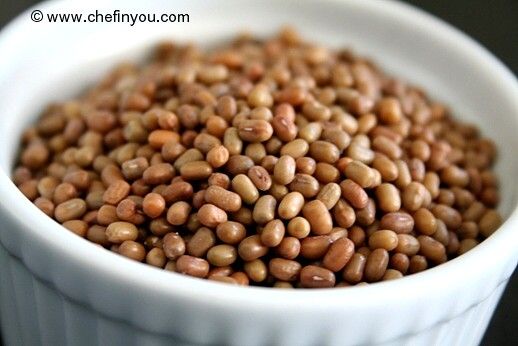Moth Beans by DK on Dec 24, 2011
Alternate Names:
Pronounced as "moat" beans and not as Moth, though the spelling says otherwise. They are also known as Moath, dew beans, papillons, muths, mot beans, mat beans, Turkish grams, and mat grams. Commonly known as "Matki" in India.
 How are they grown?
They grow in small pods on thick, matted bushes. In the winter, the pods are picked, dried and threshed, either by hand or mechanically.Moth beans can be found under cultivation throughout Southeast Asia and the Middle East. They are also sometimes cultivated in the Mediterranean, in places like Italy. The hardy creeping plant favors arid conditions, and neutral to acidic soils. The plant produces bright yellow flowers which turn into elongated seedpods, which will ultimately produce small seeds around the size of a grain of rice. These seeds can be dried and cooked, or saved for planting next year.
If you want to grow moth beans, start by preparing a patch of soil in a warm, dry part of the garden. You may want to amend the soil with sand to promote good drainage, and avoid the use of excessive mulch, which will retain water. You can either start seedlings indoors or plant the beans outdoors in the early spring; keep them lightly watered until they sprout and establish themselves, and then allow the soil to dry between waterings. Provide runners to encourage the plant to grow up off the ground, reducing the risk of mold, mildew, and rot.
How do they look?
Small, elongated beans with a brown skin and a brownish-yellow interior. They have a nutty flavor and a strong earthy smell.
How are they grown?
They grow in small pods on thick, matted bushes. In the winter, the pods are picked, dried and threshed, either by hand or mechanically.Moth beans can be found under cultivation throughout Southeast Asia and the Middle East. They are also sometimes cultivated in the Mediterranean, in places like Italy. The hardy creeping plant favors arid conditions, and neutral to acidic soils. The plant produces bright yellow flowers which turn into elongated seedpods, which will ultimately produce small seeds around the size of a grain of rice. These seeds can be dried and cooked, or saved for planting next year.
If you want to grow moth beans, start by preparing a patch of soil in a warm, dry part of the garden. You may want to amend the soil with sand to promote good drainage, and avoid the use of excessive mulch, which will retain water. You can either start seedlings indoors or plant the beans outdoors in the early spring; keep them lightly watered until they sprout and establish themselves, and then allow the soil to dry between waterings. Provide runners to encourage the plant to grow up off the ground, reducing the risk of mold, mildew, and rot.
How do they look?
Small, elongated beans with a brown skin and a brownish-yellow interior. They have a nutty flavor and a strong earthy smell.
 Buying and storing
Because of its size and color, moth attracts adulteration and almost always contains dust and small stones which are mixed with it. Pick out the impurities before cooking and rinse it well in cold water. Store in an airtight jar for upto 1 year.
How to use in Cooking?
Moth beans have a rich, nutty flavor which can complement an assortment of dishes.
Buying and storing
Because of its size and color, moth attracts adulteration and almost always contains dust and small stones which are mixed with it. Pick out the impurities before cooking and rinse it well in cold water. Store in an airtight jar for upto 1 year.
How to use in Cooking?
Moth beans have a rich, nutty flavor which can complement an assortment of dishes.
 How are they grown?
They grow in small pods on thick, matted bushes. In the winter, the pods are picked, dried and threshed, either by hand or mechanically.Moth beans can be found under cultivation throughout Southeast Asia and the Middle East. They are also sometimes cultivated in the Mediterranean, in places like Italy. The hardy creeping plant favors arid conditions, and neutral to acidic soils. The plant produces bright yellow flowers which turn into elongated seedpods, which will ultimately produce small seeds around the size of a grain of rice. These seeds can be dried and cooked, or saved for planting next year.
If you want to grow moth beans, start by preparing a patch of soil in a warm, dry part of the garden. You may want to amend the soil with sand to promote good drainage, and avoid the use of excessive mulch, which will retain water. You can either start seedlings indoors or plant the beans outdoors in the early spring; keep them lightly watered until they sprout and establish themselves, and then allow the soil to dry between waterings. Provide runners to encourage the plant to grow up off the ground, reducing the risk of mold, mildew, and rot.
How do they look?
Small, elongated beans with a brown skin and a brownish-yellow interior. They have a nutty flavor and a strong earthy smell.
How are they grown?
They grow in small pods on thick, matted bushes. In the winter, the pods are picked, dried and threshed, either by hand or mechanically.Moth beans can be found under cultivation throughout Southeast Asia and the Middle East. They are also sometimes cultivated in the Mediterranean, in places like Italy. The hardy creeping plant favors arid conditions, and neutral to acidic soils. The plant produces bright yellow flowers which turn into elongated seedpods, which will ultimately produce small seeds around the size of a grain of rice. These seeds can be dried and cooked, or saved for planting next year.
If you want to grow moth beans, start by preparing a patch of soil in a warm, dry part of the garden. You may want to amend the soil with sand to promote good drainage, and avoid the use of excessive mulch, which will retain water. You can either start seedlings indoors or plant the beans outdoors in the early spring; keep them lightly watered until they sprout and establish themselves, and then allow the soil to dry between waterings. Provide runners to encourage the plant to grow up off the ground, reducing the risk of mold, mildew, and rot.
How do they look?
Small, elongated beans with a brown skin and a brownish-yellow interior. They have a nutty flavor and a strong earthy smell.
 Buying and storing
Because of its size and color, moth attracts adulteration and almost always contains dust and small stones which are mixed with it. Pick out the impurities before cooking and rinse it well in cold water. Store in an airtight jar for upto 1 year.
How to use in Cooking?
Moth beans have a rich, nutty flavor which can complement an assortment of dishes.
Buying and storing
Because of its size and color, moth attracts adulteration and almost always contains dust and small stones which are mixed with it. Pick out the impurities before cooking and rinse it well in cold water. Store in an airtight jar for upto 1 year.
How to use in Cooking?
Moth beans have a rich, nutty flavor which can complement an assortment of dishes.
- It is mostly cooked dry with spices, coconut and fresh cilantro/coriander leaves.
- They can also be enjoyed as a thick puree to be eaten with rice
- Sprouted Moth is stir-fried with a few spices and eaten with Pau/ Dinner rolls as a snack.
- Goes very well with fried onions which add a touch of sweetness to the nuttiness of beans.
- The young seed pods are often eaten whole as vegetables, and they can also be spices in chutneys and used in pickled foods.
- When allowed to dry, the beans are cooked and then used in curries, salads, and other dishes.
- They are reasonably nutritious, making them a good addition to the vegetarian diet, and many people enjoy the nuttiness of moth beans in foods like risotto, couscous, and soups.
- http://www.wolframalpha.com/entities/foods/moth_bean/b9/3q/gt/
- http://www.fatfreekitchen.com/nutrition/nutrition-lentils.html

- http://en.wikipedia.org/wiki/Moth_bean
- http://www.wisegeek.com/what-are-moth-beans.htm
- www.tarladalal.com
Browse By these popular categories
- 154 Baking
- 287 Course
- 366 Cuisine
- 206 Healthy Foods
- 44 How to's
- 6 Instant Pot Recipes
- 1 Kid Friendly Recipes
- 94 Occasions
- 18 OPOS- One Pot One Shot Recipes
- 1 Slow Cooker Recipes
- 24 Special Diets
- 3 Student/Bachelor Cooking Recipes
Recent Articles by ChefInYou
Ganesh Chavithi ( Vinayaka Chaturthi) Festival 2020 Recipes By DK on Aug 16, 2020
Krishna Jayanthi | Gokulashtami Festival Recipes By DK on Aug 8, 2020
OPOS Lessons: How to Standardise your Pressure cooker? By DK on Jan 28, 2019
6 things I never thought I will ever do! By DK on Aug 1, 2018
Super Bowl Recipes 2018 By DK on Jan 28, 2018
7 Ways OPOS® Cooking Improved My Life By DK on Nov 19, 2017
Prepping Staples – Planning my Weekly Menu By DK on Nov 13, 2017
6 Quick & Healthy After School Snacks (with Variations) By DK on Sep 6, 2017
Bell Peppers (Capsicum): Planting, Growing & Harvesting for Beginners By DK on Aug 9, 2017
OPOS® – Frequently Asked Questions By DK on Jul 21, 2017
Recent Posts by ChefInYou
Instant pot Applesauce By DK on Nov 30, 2020
Vegetable Pulao using RightRice By DK on Oct 28, 2020
Classic Oatmeal using Sprouted Rolled Oats By DK on Oct 21, 2020
Pita Tostada By DK on Oct 14, 2020
Green Chutney / Hari Chutney (Chaat) By DK on Oct 7, 2020
Leave a Reply
I love to hear from you! I read each and every comment, and will get
back as soon as I am able to.
2 Comments
By xanga.com on Jun 3, 2013
Superb, what a blog it is! This web site gives valuable facts to us,
keep it up.





By Mamata on Jun 4, 2014